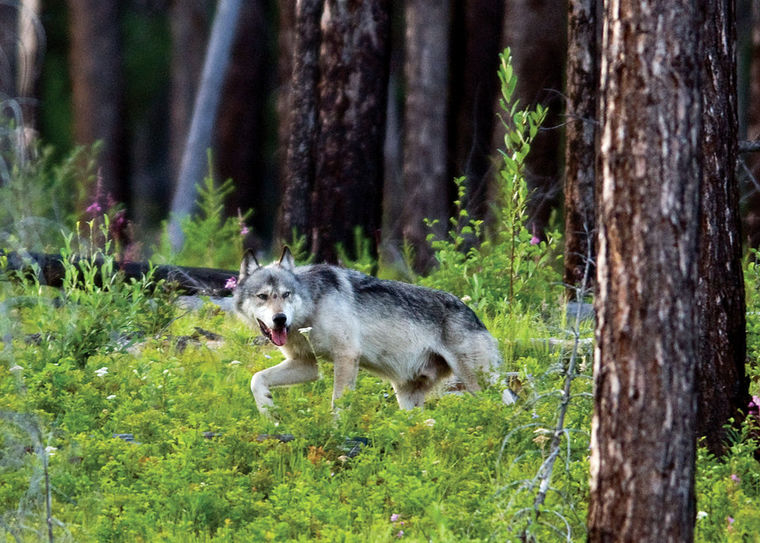
Anyone who has ever spent time in the North Fork of the Flathead has probably run across a wolf track, heard their calls or even witnessed a wolf.
But it wasn’t always that way. In the late 1800s the U.S. government declared war on the wolf. They were systematically shot, trapped and poisoned for the next 50-plus years, until in 1936, the last known wolf in the American West was killed by a government trapper.
University of Montana professor emeritus and biologist Bob Ream began studying wolves in the mid to late 1960s in the Boundary Waters Canoe area of northern Minnesota, where there were still about 300 wolves living.
In the fall of 1969 he moved to Montana and a few years later, in 1973, he started the wolf ecology project at UM. While wolves were considered extirpated from the state, there were still plenty of reports and wolf sightings through the years. From 1972 to 1979 Ream mapped the sightings — some were confirmed, some weren’t, but a pattern emerged — wolves were most often sighted along both sides of the Continental Divide. In 1973 the gray wolf was listed under the Endangered Species Act.
In 1978 Ream hired young biologists Ursula Mattson and Joe Smith to search for packs and in 1979 the first known wolf was trapped in the North Fork in British Columbia, just four miles north of the border.
The young female wolf would cross back and forth from the province to the Park and in 1981 and 1982 a black male showed up. By then, biologist Diane Boyd had been brought on by Ream and she was trapping wolves in the region.
The male and female wolf mated and the Magic Pack was born.
“That was the start of it all,” Ream said during a talk recently at Flathead Valley Community College.
The pack had a huge range — more than 1,000 square miles. By 1986 the pack had 12 wolves and wolves from that pack split off and began denning in Glacier Park’s Sullivan Meadow. It was the first den in the western U.S. in 50 years.
Over the decades more and more wolves migrated south from Canada. The Magic Pack also had dispersal wolves that went north — one wolf went more than 550 miles north to the Peace River.
About 10 percent of the 287 wolves that were studied over the years dispersed, Ream noted.
“They travel long distances in a short period of time,” he said. “A couple of weeks.”
In Northwest Montana, slowly, but surely, the wolf population recovered with protections from hunting, trapping and poisoning. In 1995, wolves from Canada were first reintroduced to Yellowstone National Park and also in Central Idaho. The move was controversial, and still is today in some circles, but wolves in the region rebounded there as well.
In 2009 wolves were initially delisted from the ESA. After lawsuits and political wrangling they were relisted in 2010 and in 2011 they were delisted again in Montana and Idaho.
In Northwest Montana, purely through natural dispersal and reproduction, there were an estimated 400-plus wolves by 2013. The entire state had more than 600, minimum, and Ream said the number today is likely closer to 750 to 800 statewide.
Today hunters and trappers harvest about 200 wolves annually. In 2013 they took 230, in ‘14, 206. Hunters had taken 90 statewide by the end of hunting season and trapping season had just started up.
Ream sees both wolf numbers and harvest leveling off in the coming years. Even where wolves aren’t hunted, their numbers tend to stabilize over time. In Yellowstone National Park, for example, the population has held steady for several years now, with 90 to 95 roaming its landscape.
But wolves can still quickly spark controversy. In the Bitterroot they were most recently blamed for the reduction of the elk population. But a multi-year study there found that elk calf mortality was caused by other predators, namely mountain lions and black bears. Lions, the study found, ate 37 percent of all the documented elk calf mortalities in the study.
Wolf hunting appears to make them far more wary of humans. Since hunting and trapping has been allowed, wolf depradations on domestic sheep and cattle has dropped. In the case of sheep, it’s dropped dramatically. Part of that has been due to ranchers learning to live with wolves — keeping herds behind fencing during lambing and calving times.
But wolf behavior has certainly changed as well, Ream noted.
In the North Fork, studies of radio-collared ungulates in the 1990s like deer and elk showed that wolves primarily fed on deer, particularly when the snows became deep and deer were easier to catch.
Mountain lions took more elk in that study as well.
When it comes to wolves, noted wolf biologist David Mech probably summed them up the best, Ream noted.
“The wolf is neither the sinner nor the saint, except those who want to make it so,” he said.
Bob Ream, witness to wolf recovery history – Hungry Horse News: Hungry Horse News.
